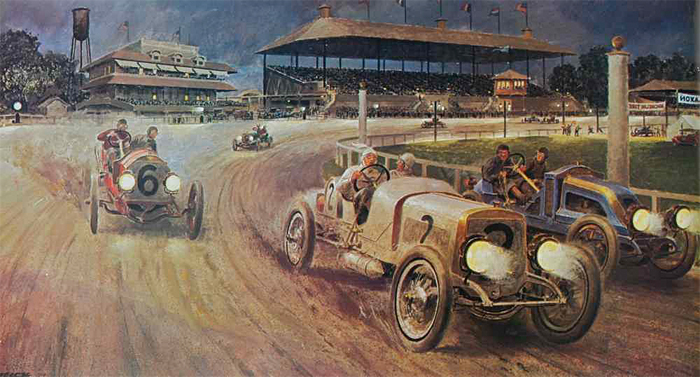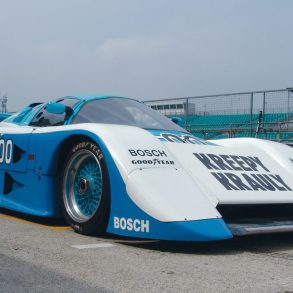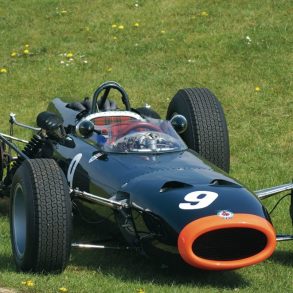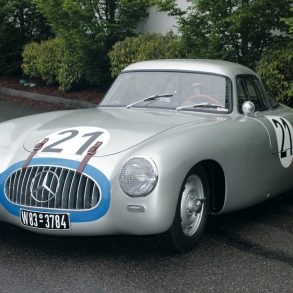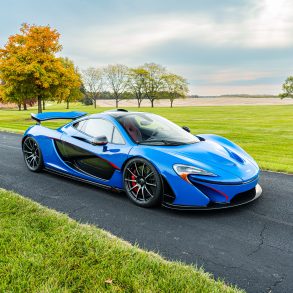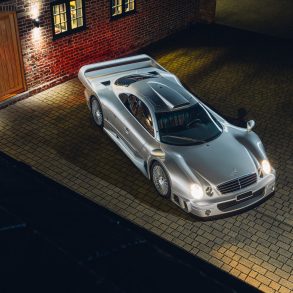Notable American Grand Prix Drivers
Michael Andretti

He should have stayed in America. Fighting an ill-handling car, skeptical fellow racers and unfamiliar tracks he lasted less than a year. His success in America attest to his ability but a seeming lack of commitment to the European championship doomed him from the start.
Other American drivers may cite this as the result of straying too far from home and rob the rest of the world of future Mario Andrettis and Dan Gurneys not to mention the Jimmy Murphys and Bruce-Browns..
Bob Bondurant

In 1963, Bondurant joined Carroll Shelby’s Ford Cobra team. Subsequent wins in the Cobra led to a stint in Europe with the Cobra team to compete for the 1964 GT Championship. Paired with Dan Gurney that year, Bondurant won the GT category and took fourth overall at the wheel of a Ford Cobra Daytona Coupe in Europe’s most prestigious race – Le Mans.
Bondurant continued to drive in Europe through 1965, winning seven out of ten races, and earning the World Manufacturers’ Championship for the United States in a Shelby American Ford Cobra. The year also afforded him the opportunity to race Formula One for the factory Ferrari team in the 1965 U.S. Grand Prix at Watkins Glen.
In 1966, Bondurant continued in Formula One driving a privately-owned BRM and for Gurney’s All American Racers team. At Spa under severe weather conditions he along with Graham Hill saved Jackie Stewart when Stewart’s car crashed trapping the Scottish driver as fuel was seeping from the stricken BRM.
He also drove for Ferrari in the 1966 World Manufacturers’ Championship. In addition, Bob served as a technical consultant for John Frankenheimer’s epic movie Grand Prix. Among the highlights of working on the film, Bondurant was responsible for training the actors including James Garner, Yves Montand and Brian Bedford for their driving roles.
In 1967 he raced in the Can-Am series but was involved in a major crash while driving a McLaren Mk II when the steering arm broke at over 150 miles per hour, launching the car into a dirt embankment and rolling end over end eight times.
The accident forced Bondurant’s retirement from professional racing but did not extinguish his desire for motor sports. Today he still enters numerous vintage racing events as well as operating a well respected driving school.
Jimmy Bryan

In 1958 he returned to Monza for another Race of Two Worlds and finished second to Jim Rathman. In 1960, Bryan, 33, died in a first-lap crash at Langhorne.
Ronnie Bucknum

His best finish was a fifth place in the Mexico GP in 1965, the race where Ginther scored Honda’s first win. Bucknum drifted away from Formula One and concentrated on racing in America. In 1992 Ronnie Bucknum died from diabetes.
Eddie Cheever

In 1980 he became a full-time driver for the Osella team which did little for his career. In 1981 he drove for Tyrrell and had five points-scoring finishes. In 1983 he drove alongside Alain Prost at Renault and had his best years finishing 6th in the World Championship.
After stints with Benneton and Arrows, Cheever joined CART in 1990. He was the 1990 CART and Indy 500 Rookie of the Year. He finished eighth at Indy in 1990 and fourth in 1992. In 1998 he scored his greatest victory at that year’s Indianapolis 500.
Louis Chevrolet

He drove a Fiat in his first race and came to the attention of William C. Durant and the Buick racing team. He scored several victories and came close to winning the Vanderbilt Cup in 1910 before suffering a broken steering knuckle with eight laps to go. In 1911 he stopped racing and was contracted to design a series of Chevrolet passenger cars for the company that later would become General Motors. This lasted for two years before a disagreement with Durant and a desire to return to racing he formed his own company under the Frontenac name.
He was joined by his brother Gaston and Tommy Milton who would each win the Indianapolis 500. After his retirement Chevrolet continued as a consulting engineer until his death in 1941.
Geirge Follmer

His best finish was a third place at the Spanish Grand Prix but by that time he was already 39 years of age, old for a Grand Prix driver.
He returned to the US the following year and raced in the Can-Am and later Trans-Am series. Today he continues to race and win in various vintage races.
Harry Grant

Famous for their namesake they decided to build a car but not just any car, theirs was as strong as a locomotive and was called the Alco. The employees of the company were justly proud of their new car, none more so than Harry Fortune Grant. Grant was a large man measure almost 6 feet and weighing 200 pounds. In 1906 he was the chief test driver for the American Locomotive Company.
He pleaded with the company directors to be allowed to race the car. In 1907 he left the company headquarters and went to work for one of their dealers in Boston. C.F. Whitney, the proprietor bought a special 40 hp car from the factory and Grant with his riding mechanic Frank Lee had his chance. In September they entered a series of races in Massachusetts, winning the five- and twenty-mille events while just missing out on the fifty-miller when a tire burst.
In 1909 Grand was now racing officially for the factory and his greatest victory occurred that same year in the Vanderbilt Cup. In 1910 he repeated his feat with another victory but at the end of 1911 the factory pulled out of racing and Grant resumed his testing duties.
Masten Gregory

As far away from the glamorous environment of Formula One as was possible yet Carol Shelby said of Gregory that, “He was the fastest American that ever went over to drive a Grand Prix car.” In 1957, driving a year old Maserati for the independent Scuderia Centro Sud team he qualified on the front twice including in his first Grand Prix. Gregory was also involve in numerous sports racing and several times suffered injuries from major accidents which interrupted his Grand Prix racing.
Timing is everything and Gregory was never able to fulfill his early promise. Yet he did win at Le Mans in 1965 and that same year he entered Indianapolis. Staring from the last row he passed 14 cars before turn one and made his way up to 5th place before dropping out due to engine problems.
Jim Hall

He was successful from the start and entered the United States Grand Prix in 1960 coming home 7th. In 1961 he commissioned Scarab to build him a car which was christened the first Chaparral. After racing the car he became convinced that he could build one better.
In partnership with “Hap” Sharp he did just that. Jim Hall continued to race cars and in 1963 he raced for the British Racing Partnership (BRP) team in Formula 1. His best finish was a 5th in Germany at the famous Nurburgring. Ironically the engineer Hall was not allowed to talk directly to his mechanics and had to relay any suggestions concerning his car through the team manager. The thought of this great innovator being so restricted boggles the mind.
George Heath

He rewarded his new employer with a victory at the Circuit des Ardennes. Later that year he won his greatest victory the 1904 Vanderbilt Cup and followed that with a second place one year later. Heath would continue to race until 1909 but by that time Panhard was no longer the race winner it had been when the decade started.
Brett Lunger

The following year he was at Surtees and during the 1977-78 seasons he drove a private McLaren.
He is best known for his heroics out of the car when he, Vic Elford and others rescued Niki Lauda from his burning car at the Nurburgring.
Rex Mays

He owned the dangerous Legion Ascot track and claimed four pole positions at Indianapolis. He would drive at Indianapolis twelve times in his career and led nine of those but his best finish was second place.
In 1938 he drove an American modified 8C-35 Alfa Romeo to third place in the George Vanderbilt Cup race behind the Auto Union of Rosemeyer and the Mercedes of Dick Seaman.
George Robertson

He raced a Christie, a Hotchkiss as well as a Locomobile with which he won the 1908 Vanderbilt Cup. This victory was the first major race won by an American driver racing a car made in the United States. This car was the legendary “Old No. 16”. In 1910 he was the captain of the Benz team but was injured while showing a newspaper reporter the course and was forced to retire from driving.
In 1921 he served as Dusenberg’s team manager in their victorious challenge of the French Grand Prix. He later was the vice president and general manager of Roosevelt Raceway, host to the George Vanderbilt Cup.
Caroll Shelby

Shelby used to race only after doing the morning chores on the farm and one day raced in his striped bib overalls which became his trademark. While racing sports cars in Europe he drove a couple of Grand Prix races for the Scuderia Centro Sud team. In 1959 he was hired to drive the new Aston Martin Grand Prix car in addition to driving their sports cars.
Unfortunately the GP car was a flop and during this period Shelby began to experience heart pains that would eventually force him to quit driving. With his driving done he set about to make his mark on the history of motor sports with his own cars first the AC Cobras, then a partnership with Dan Gurney to form All-American Racers AAR and later assisting in Ford’s GT40 Le Mans winning program.
Harry Schell

In the early fifties he graduated to Formula One and drove the first modern rear-engined car (Cooper-JAP) at Monaco in 1950. While at Maserati he came in 2nd at the Rome Grand Prix followed by a third at Aintree. In 1956 he drove for Vanwall most of the year but in 1957 he switched back to Maserati and scored a pair of second place finishes Pau and Silverstone.
He was a very popular driver who was a partner in a bistro, L’Action Automobile which was a gathering place with the racing scene. His love for the nightlife would sometimes effect his driving but occasionally he could be very quick. In 1960 he was killed while practicing in the wet at Silverstone.
Danny Sullivan

Yet, he spent much of his earlier career racing in Europe and in 1983 he drove for Tyrrell in Formula One. His best race was at Monaco where he came in 5th.
In 1984 he was out of Formula 1 and racing in America.
Joe Tracy

Additional clients who needed instruction in the operation and maintenance of these new machines began to come his way. Soon he was racing and in 1904 he entered the first Vanderbilt Cup race. He never made it past the second lap but the following year saw him garner 2nd place in a 100-mille event in of all places Havana, Cuba.
Tracy was chosen by the ACA to represent the United States in the Gordon Bennett Race over the Auvergne Circuit but his race ended with a stripped second gear. His racing career ended soon after the 1906 race.
Billy Winn

During the race he held third place until blowing a tire on lap 64. Winn returned in 1937 with the same car and once again astounded the Europeans when he passed the Mercedes of Dick Seaman in a full-lock power slide until his car once again let down this fierce driver. Temperamental, he drank heavily and was rumored to use barbiturates; he would die the following year.
There is no doubt that while the “bull-rings” that were the American dirt-tracks retarded race car development the drivers who raced upon them were made of stronger stuff.


